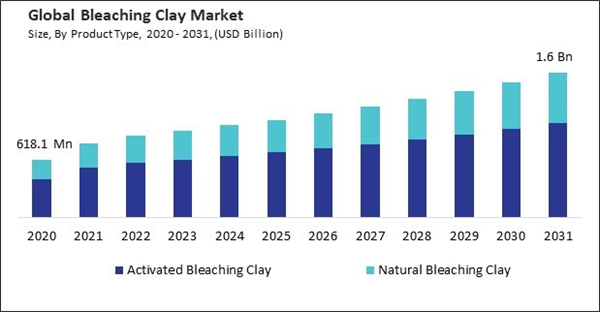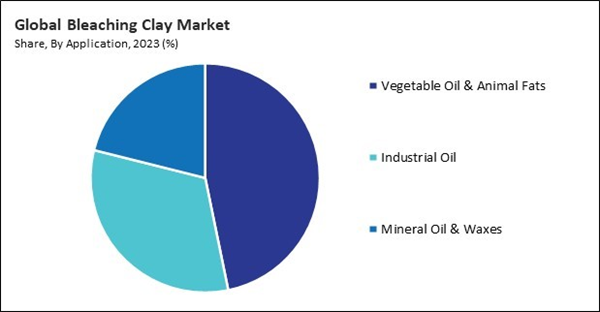The Global Bleaching Clay Market size is expected to reach $1.6 billion by 2031, rising at a market growth of 6.7% CAGR during the forecast period. In the year 2023, the market attained a volume of 2,245.69 kilo tonnes, experiencing a growth of 19.3% (2020-2023).
In contrast, bleaching clay is a natural adsorbent material that does not introduce additional harmful substances into the environment. Thus, the Industrial Oil segment acquired $299.94 million revenue in 2023. Also, the Canada market would utilize 43.55 kilo tonnes of bleaching clay in Industrial Oil segment by 2031. Bleaching clay can be regenerated and reused multiple times before it loses its adsorption capacity. This reduces the amount of waste generated during oil refining, contributing to waste minimization and resource conservation.
It is highly effective in adsorbing impurities in edible oils, such as free fatty acids, phospholipids, and trace traces of metals. These impurities can affect the oils' taste, color, and shelf life. By removing them, bleaching clay helps produce cleaner and safer oils for consumption. Thus, these factors will help in the growth of the market.
Additionally, the global population is steadily increasing, leading to a higher demand for food products, including edible oils. As more people require cooking oils for their daily meals, the production and refining of vegetable oils have to keep pace. Changing dietary habits, including a shift towards healthier cooking oils like vegetable oils, contribute to the increased demand. Hence, these factors will boost the demand for bleaching clay in the coming years.
However, the availability and quality of raw materials are pivotal factors in the bleaching clay market. Different regions have distinct geological formations that yield varying qualities of bleaching clays. Geological conditions influence factors such as mineral composition, particle size distribution, and purity of the clay deposits. Hence, these factors can decrease the demand for bleaching clay in the coming years.
In contrast, bleaching clay is a natural adsorbent material that does not introduce additional harmful substances into the environment. Thus, the Industrial Oil segment acquired $299.94 million revenue in 2023. Also, the Canada market would utilize 43.55 kilo tonnes of bleaching clay in Industrial Oil segment by 2031. Bleaching clay can be regenerated and reused multiple times before it loses its adsorption capacity. This reduces the amount of waste generated during oil refining, contributing to waste minimization and resource conservation.
It is highly effective in adsorbing impurities in edible oils, such as free fatty acids, phospholipids, and trace traces of metals. These impurities can affect the oils' taste, color, and shelf life. By removing them, bleaching clay helps produce cleaner and safer oils for consumption. Thus, these factors will help in the growth of the market.
Additionally, the global population is steadily increasing, leading to a higher demand for food products, including edible oils. As more people require cooking oils for their daily meals, the production and refining of vegetable oils have to keep pace. Changing dietary habits, including a shift towards healthier cooking oils like vegetable oils, contribute to the increased demand. Hence, these factors will boost the demand for bleaching clay in the coming years.
However, the availability and quality of raw materials are pivotal factors in the bleaching clay market. Different regions have distinct geological formations that yield varying qualities of bleaching clays. Geological conditions influence factors such as mineral composition, particle size distribution, and purity of the clay deposits. Hence, these factors can decrease the demand for bleaching clay in the coming years.
Application Outlook
On the basis of application, the market is divided into industrial oil, mineral oil & waxes, and vegetable oil & animal fats. In 2023, the mineral oil and waxes segment witnessed a 21% revenue share in the market. In terms of volume, the mineral oil and waxes segment would utilize 773.62 kilo tonnes of bleaching clay by 2031. The cosmetics and personal care industry is a major consumer of refined waxes derived from mineral oils.Product Type Outlook
Based on product type, the market is segmented into activated bleaching clay and natural bleaching clay. In 2023, the natural segment garnered a significant 33% revenue share in the bleaching clay market. In terms of volume, the natural bleaching clay segment would utilize 1,546.31 kilo tonnes of bleaching clay by 2031. Heightened awareness of environmental issues, such as climate change, pollution, and ecosystem degradation, has led consumers and industries to prioritize sustainability in product sourcing and manufacturing processes.Regional Outlook
By region, the market is segmented into North America, Europe, Asia Pacific, and LAMEA. The Asia Pacific segment procured a 39.2% revenue share in the market in 2023. In terms of volume, the Asia Pacific segment would utilize 1,539.38 kilo tonnes of bleaching clay by 2031. The region has diverse industries, including food and beverage, cosmetics, pharmaceuticals, and oil refining, all of which are major consumers of bleaching clays.List of Key Companies Profiled
- Arkema S.A.
- Clariant AG
- DuPont de Nemours, Inc.
- BASF SE
- Kemira Oyj
- Merck KGaA
- Akzo Nobel N.V.
- EP Minerals, LLC (U.S. Silica Holdings, Inc.)
- Oil-Dri Corporation of America
- Musim Mas Group
Market Report Segmentation
By Product Type (Volume, Kilo Tonnes, USD Billion, 2020-2031)- Activated Bleaching Clay
- Natural Bleaching Clay
- Vegetable Oil & Animal Fats
- Industrial Oil
- Mineral Oil & Waxes
- North America
- US
- Canada
- Mexico
- Rest of North America
- Europe
- Germany
- UK
- France
- Russia
- Spain
- Italy
- Rest of Europe
- Asia Pacific
- China
- Japan
- India
- South Korea
- Australia
- Malaysia
- Rest of Asia Pacific
- LAMEA
- Brazil
- Argentina
- UAE
- Saudi Arabia
- South Africa
- Nigeria
- Rest of LAMEA
Table of Contents
Chapter 1. Market Scope & Methodology
Chapter 2. Market at a Glance
Chapter 3. Market Overview
Chapter 4. Global Bleaching Clay Market by Product Type
Chapter 5. Global Bleaching Clay Market by Application
Chapter 6. Global Bleaching Clay Market by Region
Chapter 7. Company Profiles
Companies Mentioned
- Arkema S.A.
- Clariant AG
- DuPont de Nemours, Inc.
- BASF SE
- Kemira Oyj
- Merck KGaA
- Akzo Nobel N.V.
- EP Minerals, LLC (U.S. Silica Holdings, Inc.)
- Oil-Dri Corporation of America
- Musim Mas Group
Methodology

LOADING...










